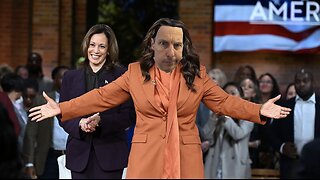Premium Only Content

A whole lot of nothing, little walk little jog, little moving rocks, little cold water plunge
Yeah not much of a talk here, just me fusing a bit over rocks.
ALSO if for some reason it turns out that this area that has been my paleogym is a Huron Wendat cemetary, I have to say in advance, that I do not distrub the site or the graves out of disrespect for the dead but rather discovery and uncovering of knowledge, if not simply of natural geological process that if for some remote reason it is not galacial till but rather a burial site, that I am learning about Huron Wendat burial practices. While I do find some of the rocks to be peculiar and the handful of hand grip feeling smaller stones in the till area nd rather strange assemblages of stones.. I still am not convinced it is a grave but am very suspicious of how the assemblage of stones at a few points occured, as well as the odd geological differences of a host of stones that don't to me make sense of how these varied stones all ended up together in this same tell or raised area of stone that juts up around the surrounding land. It is easy to see landforms in stones but this is a bit like looking at a shadow and seeing some object in it, as what is seen may not be what is actually there as the brain is able to filter objects to create meaning as opposed to meaning being dsicovered from objects although it can work this way too. None the less it is a curious site to me, but I still am not fully convinced it is not a natural formation. BUT I need to say again I ABSOLUTELY MEAN NO DISREPSECT, in fact to me this is discovery of something that is lost as opposed to desecration of the past or respect to the dead. Currently the dead is forgotten, without disvoer the past cannot be remembered. If it turns out to be a gravesite, sorry. So sorry. OK just realized this area is Odawa not Huron Wendat historically, still sorry if it turns out to be a grave. I thought I would also share a bit of the known history of the Odawa just as this is where I was led. According to Anishinaabeg tradition, and from recordings in Wiigwaasabak (birch bark scrolls), the Odawa people came from the eastern areas of North America, or Turtle Island, and from a region called Dawnland along the East Coast (where there are numerous Algonquian-language peoples). Directed by the miigis (luminescent) beings, the Anishinaabe peoples moved inland along the Saint Lawrence River. At the "Third Stopping Place" near what is now Detroit, Michigan, the southern group of Anishinaabeg divided into three groups, the Ojibwe, Odawa, and Potawatomi.[10]
There is archaeological evidence that the Saugeen complex people, a Hopewell-influenced group who were located on the Bruce Peninsula during the Middle Woodland period, may have evolved into the Odawa people. The Hopewell tradition was a widely extended trading network operating from about 200BCE to 500 CE. Some of these peoples constructed earthwork mounds for burials, a practice that ended about 250 CE.[11] The Saugeen mounds have not been excavated.
The Odawa, together with the Ojibwe and Potawatomi, were part of a long-term tribal alliance called the Council of Three Fires,[12] which fought the Iroquois Confederacy and the Dakota people. In 1615 French explorer Samuel de Champlain met 300 men of a nation which, he said, "we call les cheueux releuez" (modern French: cheveux relevés (hair lifted, raised, rolled up)) near the French River mouth. Of these, he said: "Their arms consisted only of a bow and arrows, a buckler of boiled leather and the club. They wore no breech clouts, their bodies were tattooed in many fashions and designs, their faces painted and their noses pierced."[7] In 1616, Champlain left the Huron villages and visited the "Cheueux releuez," who lived westward from the lands of the Huron Confederacy.[10]
The Jesuit Relations of 1667 report three tribes living in the same town: the Odawa, the Kiskakon Odawa, and the Sinago Odawa. All three tribes spoke the same language.
Yes good learning about, probably going to learn more about geology and how all these various stone types came about in this area..... AND learn about the Saugeen peoples even if these arn't some ancient burials of Saugeen or Odawa or some other group.. probably not burials at all, just an interesting geological area.
While all the crystalized stomes may are just representaive of hydroforming. I am still left wondering how so many smooth stones came about. Also how what appear like chiselmarks or dressing on the stones could form naturally. More study is needed to better understand how natural geological process can create such smooth stones. Especially that weird irregular shaped one with the linear cements of crystalized material.. that seems to be a truly interesting stone to learn the geology off.. and I almost saw something similar at the dock in town so much take a closer look to see if maybe that stone is similar banding.. not sure how that type of banding forms naturally it is so mortar looking in terms of uniform thickness.
-
 1:58:06
1:58:06
Jeff Ahern
2 hours agoMonday Madness with Jeff Ahern
1 -
 1:27:53
1:27:53
Game On!
11 hours agoI lost $591,000 on the New York Giants! I HATE THEM!
1541 -
 35:35
35:35
The Why Files
6 days agoThe Dark Side of the Moon | Alien Activity and the NASA Cover-Up
74.9K120 -
 2:39:28
2:39:28
Jewels Jones Live ®
2 days agoTRUMP’S TSUNAMI | A Political Rendezvous - Ep. 99
49.3K105 -
 2:12:46
2:12:46
TheSaltyCracker
15 hours agoLefties Think Elon Stole Election ReeEEeE Stream 11-10-24
223K433 -
 1:16:52
1:16:52
vivafrei
16 hours agoNEW STREAM! Sorry peeps
155K150 -
 5:56:14
5:56:14
SNEAKO
16 hours agoCheesur E-Date, Jake Shields & Myron Gaines on Election
114K8 -
 39:34
39:34
Nerdrotic
18 hours ago $59.05 earnedAirbursts with Dr Malcolm LeCompte & Giants and Ancient Civilizations with Hugh Newman - Forbidden Frontier
123K18 -
 1:03:38
1:03:38
vivafrei
1 day agoElection RECAP! Long-Count Chicanery! FULL Jan. 6 Pardons! Let's Mock Lichtman & MORE! Viva Frei
172K179 -
 7:52:09
7:52:09
Vigilant News Network
19 hours agoDoctors Drop Post-Election COVID Bombshell | Media Blackout
176K10